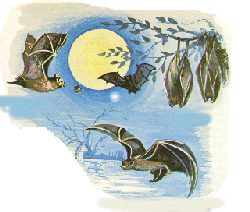
 Bat
( Ialtóg)--:Bats are mammals, this means they have a covering
of fur or hair on their body and give birth to live babies which they suckle
until they are old enough to look fter themselves. Bats are the only mammals
capable of true flight There are more than a thousand species of
bats found around the world. There are seven types of bat found in Ireland.
Six of these bays belong to the “vesper bat” group.
Bat
( Ialtóg)--:Bats are mammals, this means they have a covering
of fur or hair on their body and give birth to live babies which they suckle
until they are old enough to look fter themselves. Bats are the only mammals
capable of true flight There are more than a thousand species of
bats found around the world. There are seven types of bat found in Ireland.
Six of these bays belong to the “vesper bat” group.
the Long Eared bat,
Daubenton's bat, Natterer's
bat, Leisler's bat, Whiskered bat,and
the Pipistrelle bat –
the most common bat
found in Ireland
The seventh type of bat is known as the Lesser Horseshoe bat and it has a
type of horseshoe like growth around its mouth, that’s how it got its
name. All bats have very sharp pointy teeth. Ireland largest bat is the
Leisler’s bat and the
Pipisterelle bat is the smallest. A bat got caught up in my Mum’s
hair. The leisler bats are usually found in the east of the country. The
smallest is the pipistrelle.
They
make squeaky noises to communicate. The bat eats flying insects like moths,
dragon flies and mayflies.
Sometimes they eat spiders and beetles. They sleep in the day hanging upside
down in the dark caves or in attics. They are also found in woodland areas,
especially near water where they will find plenty of insects as food.
Bats use a
special technique to see where they are going in the dark. This is often
called radar but it is more correctly called sonar or simply,
'echolocation'. A bat produces a high pitched sound normally beyond the
hearing range of humans. When the sound hits against the
They do not have great eyesight, but they can see.that is why you will hear people saying to others “your as blind as a bat”, but this is not really true as they can see as well as hear.
Bats
hibernate from October until March. All seven
Irish bats hibernate. Bats live
during the winter in rock formations such as caves and cellars and undergo
very strange body changes to enable them to survive without feeding for
several months. Bats maintain a body temperature of 37'C but during
hibernation, a bat will lower and maintain its body temperature at or below
10'C. As a bat enters hibernation, its heartbeat falls from a level of
several hundred beats per minute to about a figure of 5-20 beats a minute,
the blood flow around the body is reduced and breathing becomes much slower.
The energy needed to sustain a bat in hibernation is stored as body
fat,which the bat builds up during long feeding periods in Autumn.
Hibernating bats do not like to be disturbed by anything or anybody. A bat
with a body temperature of 10'C takes at least 15 minutes to wake up and fly
away from danger. If a bat wakens too often during hibernation it could die
before winter ends.
They
hibernate because food is scarce around at the Autumn time of year.
All Irish
bats eat insects which they catch in the air or take from branches or of
trees or even from the ground mostly between dusk and dawn. A wide range of
insects is eaten, including tiny midges, large moths, beetles,
caddis-flies,daddy long-legs, earwigs and spiders.
Bats are
not harmful and people should not be afraid of bats. Kenneth’s sister got
a pet bat.
Bats
are protected in Ireland under the Wildlife Act of 1976.
Gerard
Stubbs